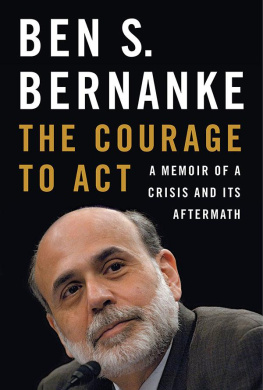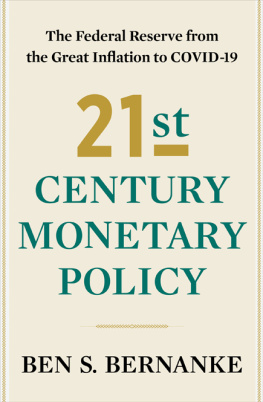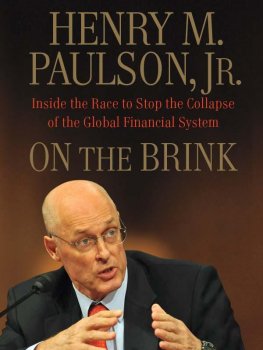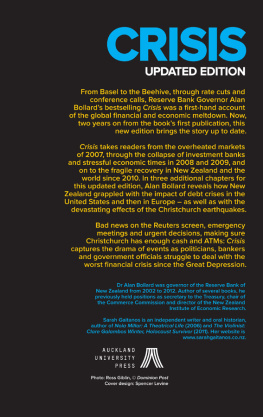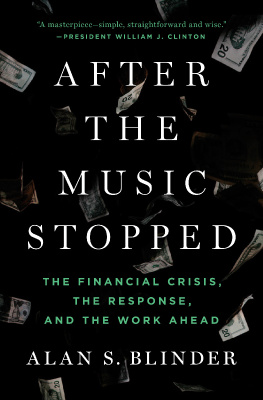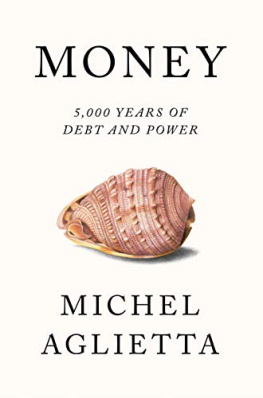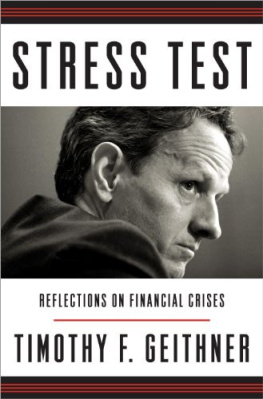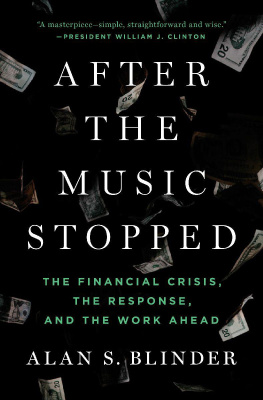CONTENTS
In all crises, there are those who act and those who fear to act. The Federal Reserve, born of the now little-known Panic of 1907, failed its first major test in the 1930s. Its leaders and the leaders of other central banks around the world remained passive in the face of ruinous deflation and financial collapse. The result was a global Great Depression, breadlines, and 25 percent unemployment in the United States, and the rise of fascist dictatorships abroad. Seventy-five years later, the Federal Reservethe institution that I have dedicated the better part of my adult life to studying and servingconfronted similar challenges in the crisis of 20072009 and its aftermath. This time, we acted.
The title of this book was inspired by my colleagues at the Federal Reserve, policymakers and staff alike. When the economic well-being of their nation demanded a strong and creative response, they mustered the moral courage to do what was necessary, often in the face of bitter criticism and condemnation. We were joined in the fight by others in governmentthe leaders and staff of the Treasury Department under two administrations deserve special noteas well as many of our counterparts at central banks and finance ministries around the world. I am grateful to all of them and proud to have been part of the global effort to contain the most dangerous economic crisis of our time.
I am most grateful, however, to my wife, Anna, the love of my life, for suggesting the books titleand for so much more, as will become clear.
I Can Still Stop This...
I t was 8:00 p.m. Tuesday, September 16, 2008. I was exhausted, mentally and emotionally drained, but I could not sit. Through the windows of my office in the Federal Reserves Eccles Building, I could see the lights of the traffic on Constitution Avenue and the shadowy outlines of American elms lining the National Mall. Dozens of staff members remained at work, but the corridor immediately outside my door was hushed and empty. Michelle Smith, the head of our communications office and my chief of staff, sat quietly, the only other person in the room. She was waiting for me to say something.
FOUR HOURS EARLIER, Treasury secretary Hank Paulson and I had sat side by side in tan leather armchairs in the windowless Roosevelt Room of the White House, steps from the Oval Office. A portrait of Teddy Roosevelt as Rough Rider on a rearing horse hung above a fireplace. Facing Hank and me across the rooms polished wood table sat the current occupant of the White House, a somber George W. Bush, with Vice President Dick Cheney at his side. The presidents advisers, Hanks senior aides, and representatives of other financial regulatory agencies filled the remaining dozen seats around the table.
Usually, the president liked to keep things light at meetings, by opening with a wisecrack or good-naturedly teasing a close adviser. Not that afternoon. He asked bluntly, How did we get to this point?
The question was rhetorical. We had been fighting an out-of-control financial crisis for more than a year. In March, the Fed had lent $30 billion to help JPMorgan Chase save the Wall Street investment bank Bear Stearns from failure. In early September, the Bush administration had taken over Fannie Mae and Freddie Mac to prevent the collapse of the two companies responsible for financing roughly half of all residential mortgages in the United States. And just the day before, at 1:45 a.m., Lehman Brothersthe nations fourth-largest investment bankhad filed for bankruptcy, following a frantic and ultimately futile search for a merger partner led by Hank and New York Fed president Tim Geithner.
Now I found myself explaining to the president why the Federal Reserve was planning to lend $85 billion to American International Group (AIG), the worlds largest insurance company. The company had gambled recklessly, using exotic financial instruments to insure securities backed by subprime mortgages. Now that those mortgages were going bad at record rates, the financial firms that had bought the insurance, together with other AIG counterparties, were demanding payment. Without the cash, AIG would go bankrupt within days, perhaps hours. We werent motivated by any desire to help AIG, its employees, or its shareholders, I told the president. Rather, we didnt think that the financial systemand, more importantly, the economycould withstand its bankruptcy.
Reacting to the Lehman failure, markets already were in the grip of a full-blown panic of an intensity not seen since the Depression. The Dow Jones industrial average had plunged 504 points on Mondayits steepest one-day point decline since September 17, 2001, the first day of trading after the September 11 terrorist attacksand the selling wave had spread to markets worldwide. As confidence in financial institutions disappeared, interest rates on loans between banks had shot skyward. Ominously, we were receiving reports of both large and small investors pulling their cash out of money market mutual funds after a large fund suffered losses stemming from Lehmans collapse.
Everyone in the room knew that rescuing AIG would be terrible politics in a presidential election year. Just two weeks earlier, the presidents own party had declared flatly in its 2008 convention platform, We do not support government bailouts of private institutions. The Federal Reserves proposed intervention would violate the basic principle that companies should be subject to the discipline of the market and that the government should not shield them from the consequences of their mistakes. Still, I knew that, as chaotic as financial conditions were now, they could become unimaginably worse if AIG defaultedwith unknowable but assuredly catastrophic consequences for the U.S. and global economies.
With more than $1 trillion in assets, AIG was more than 50 percent larger than Lehman. It operated in more than 130 countries and had more than 74 million individual and corporate customers worldwide. It provided commercial insurance to 180,000 small businesses and other corporate entities employing 106 million peopletwo-thirds of American workers. Its insurance products protected municipalities, pension funds, and participants in 401(k) retirement plans. AIGs collapse could well trigger the failures of yet more financial giants, both in the United States and abroad.
The president, grim-faced, listened carefully. Paulson had warned him earlier in the day that action on AIG might be necessary, and he knew that our options were severely limited. No private investors were interested in buying or lending to AIG. The administration had no money and no authority to rescue it. But the Fed could lend to AIG to keep it afloat if the companys many subsidiaries retained enough value to serve as collateral for the loan.
Bush responded as he had consistently during the financial crisis, by reiterating his trust in Hanks and my judgment. He said that we should do what was necessary, and that he would do what he could to provide political cover. I was grateful for his confidence, and for his willingness to do the right thing regardless of the likely political consequences for himself and his party. Having the presidents support was crucial. At the same time, essentially, the president was telling Paulson and me that the fate of the U.S. and global economies was in our hands.
OUR NEXT MEETING, at half past six that evening at the Capitol, had been even tougher. Hank and I gathered with congressional leaders in a cramped conference room. House Speaker Nancy Pelosi wasnt able to attend the hastily arranged gathering, but Senate majority leader Harry Reid and House minority leader John Boehner were there, along with Senate Banking Committee chairman Chris Dodd, House Financial Services Committee chairman Barney Frank, and several others.

